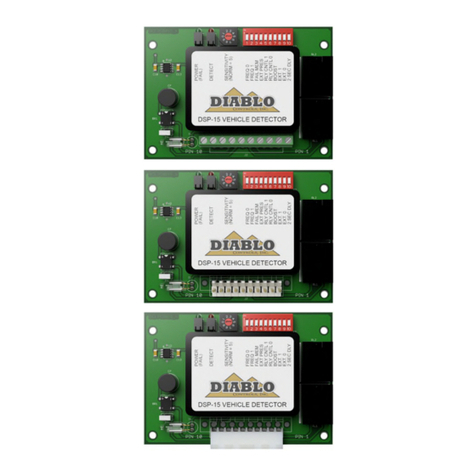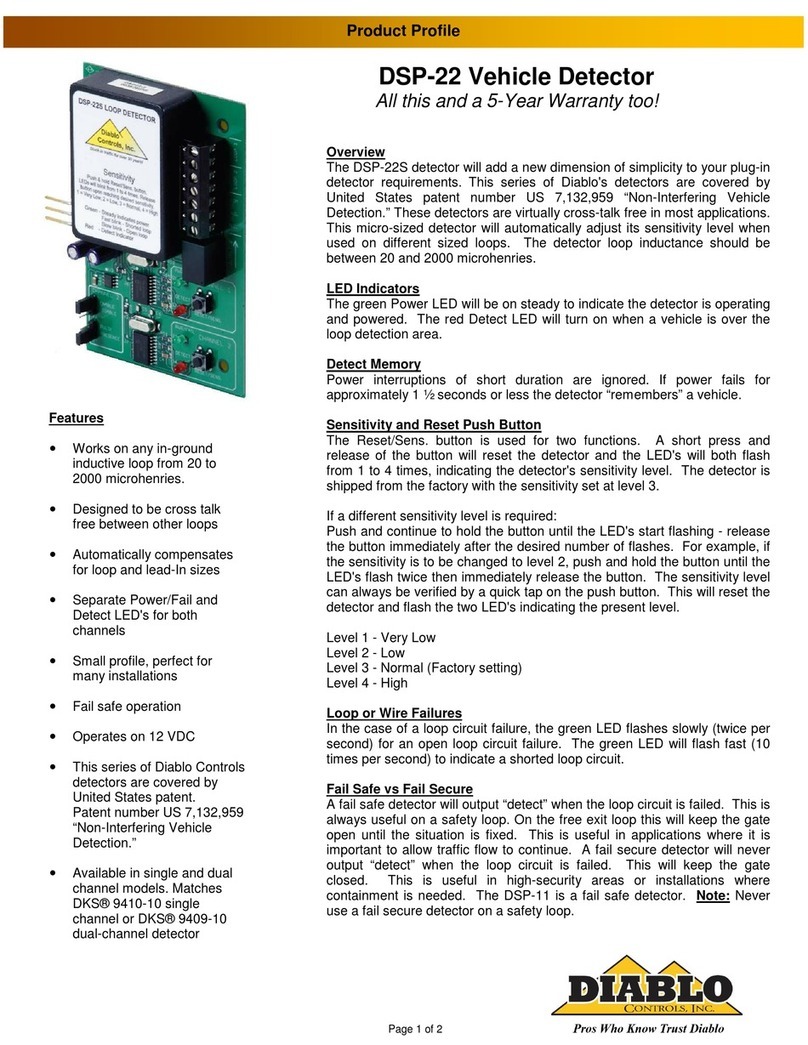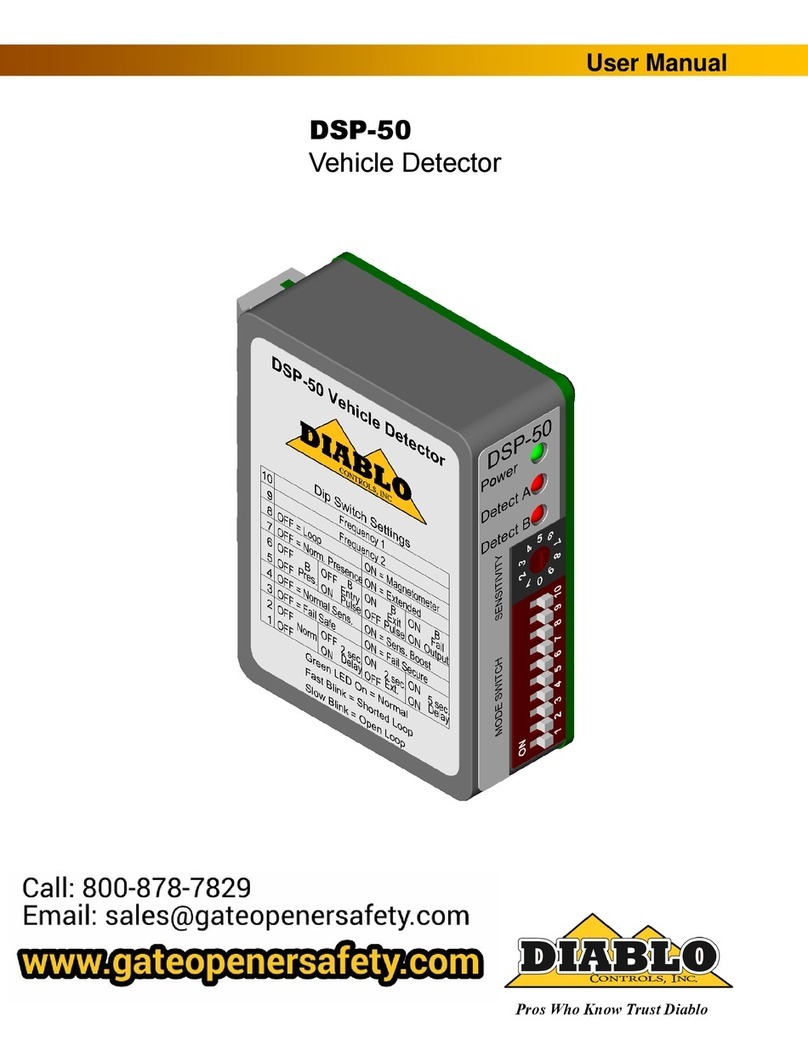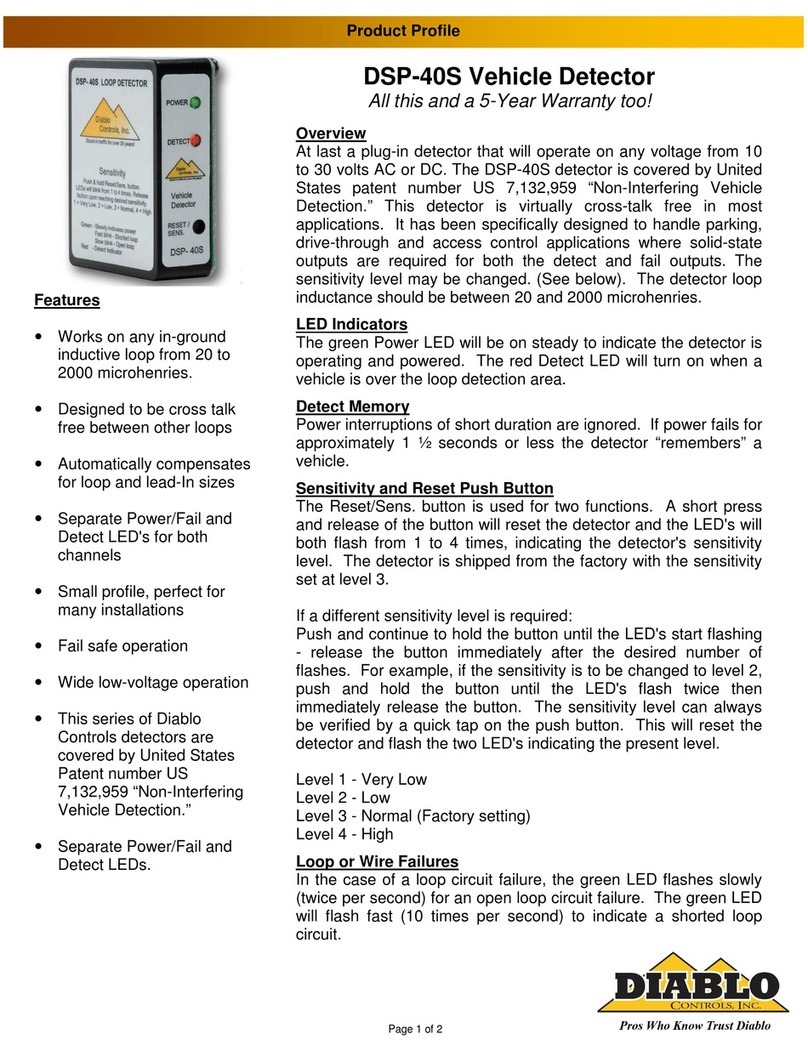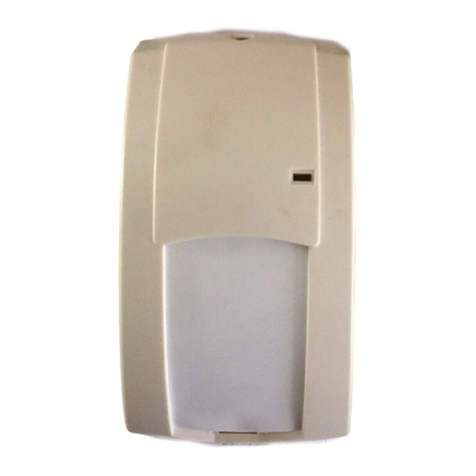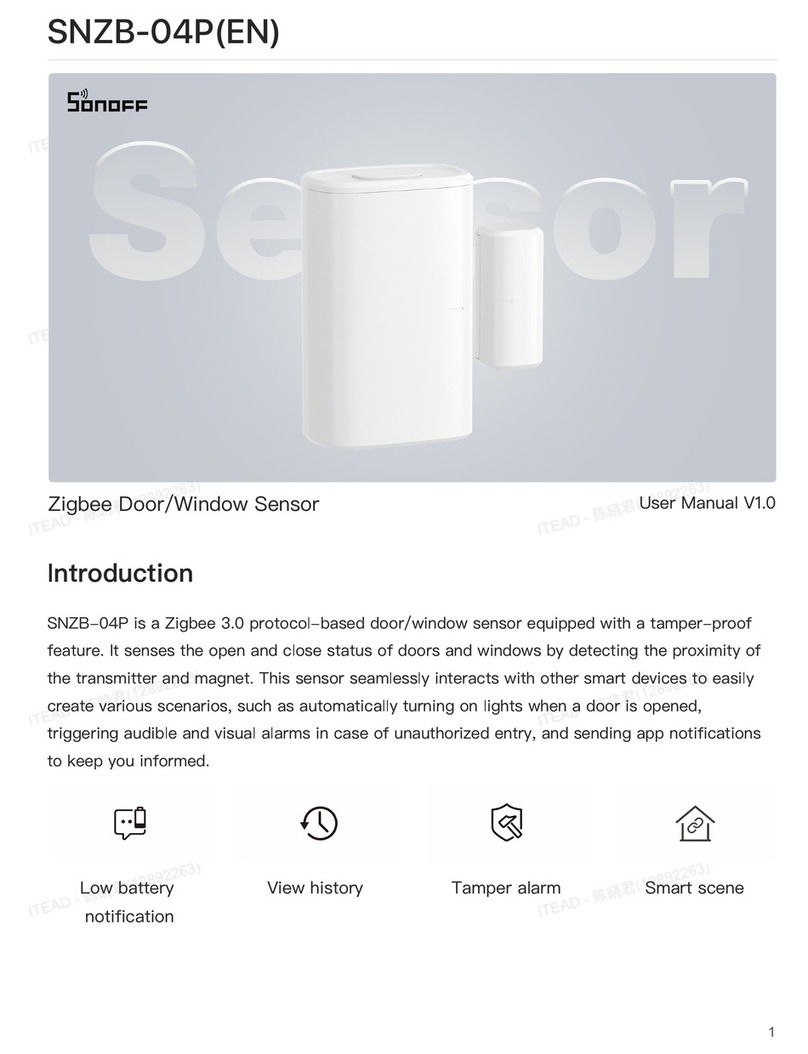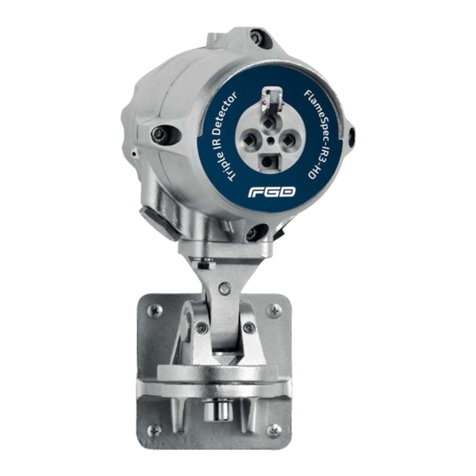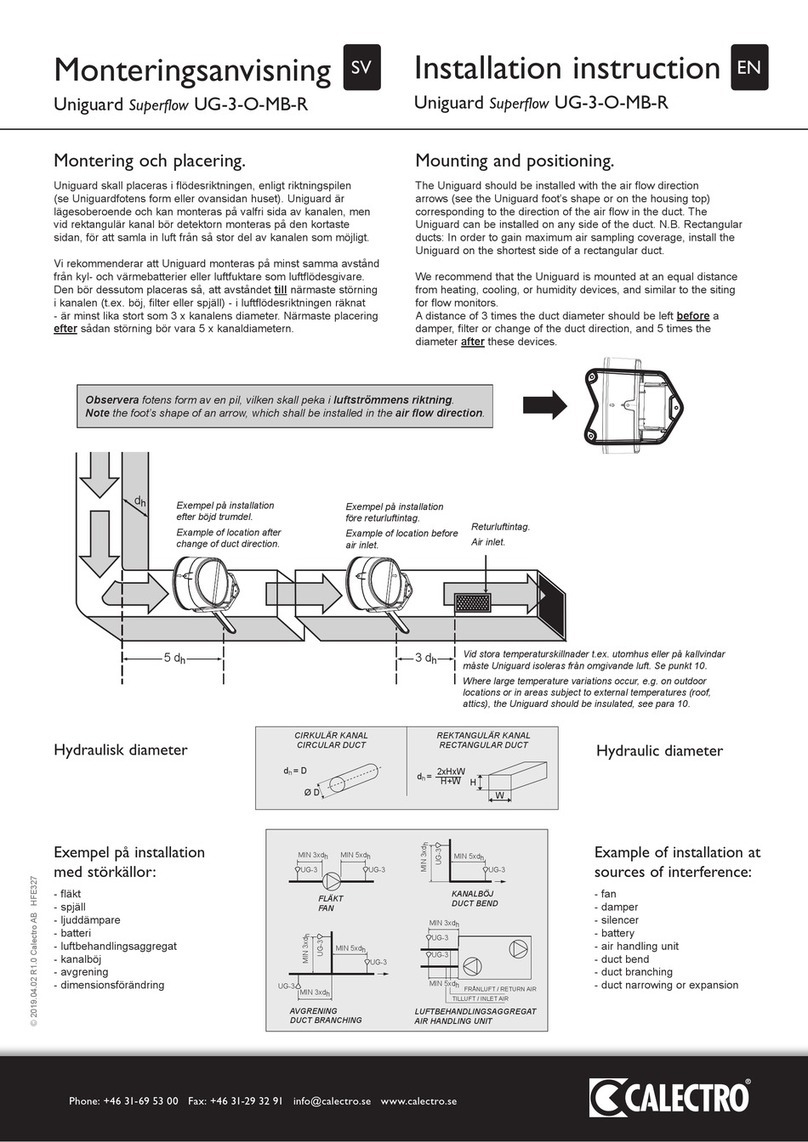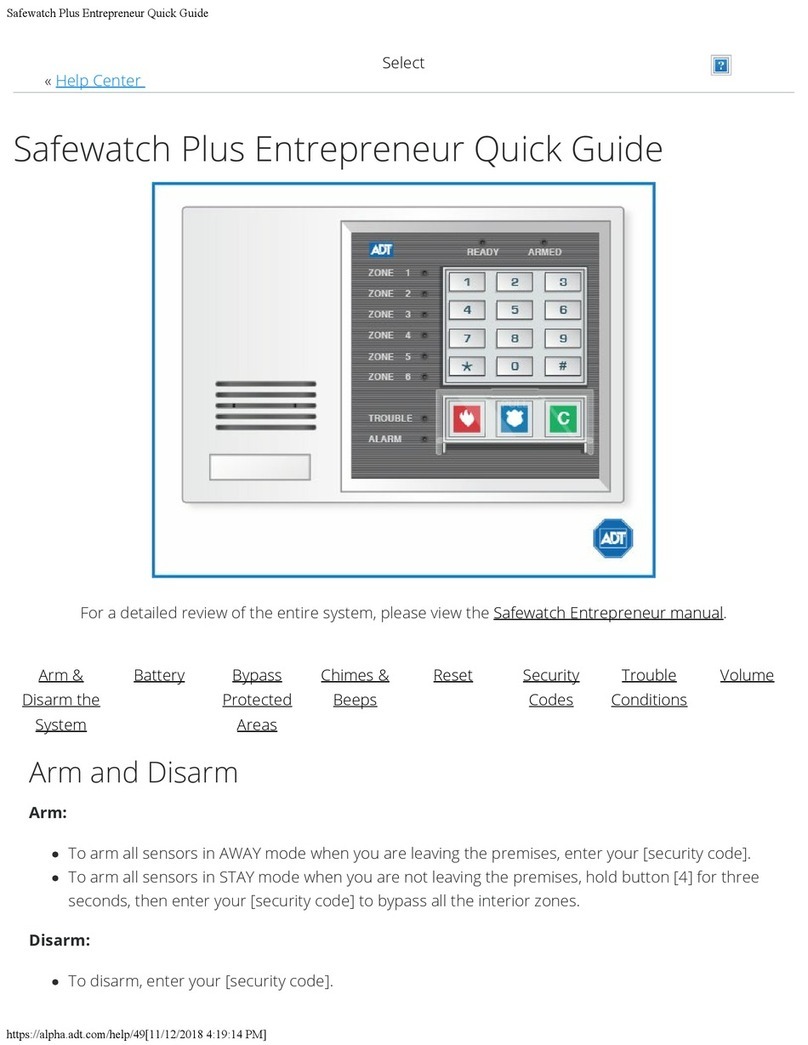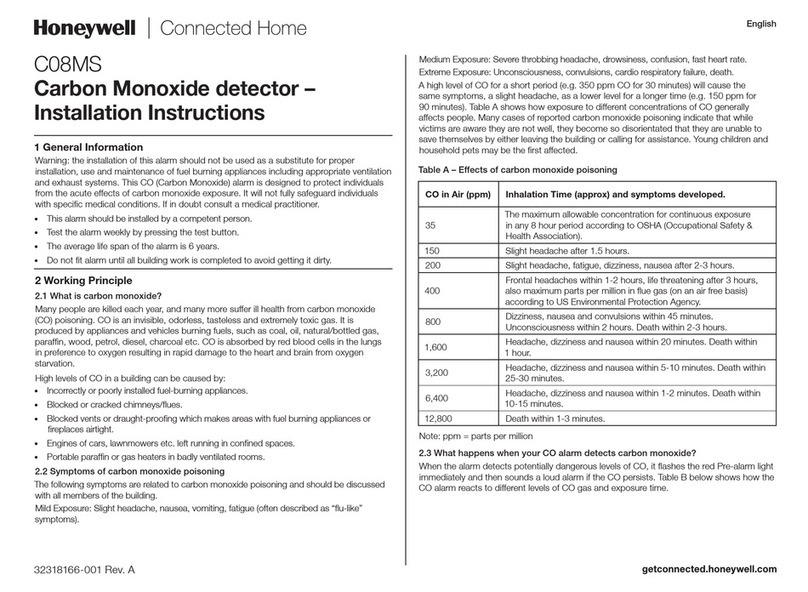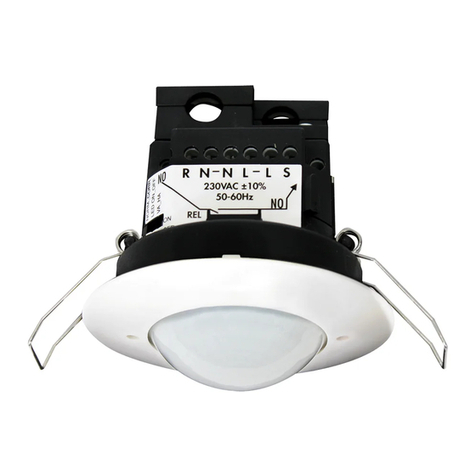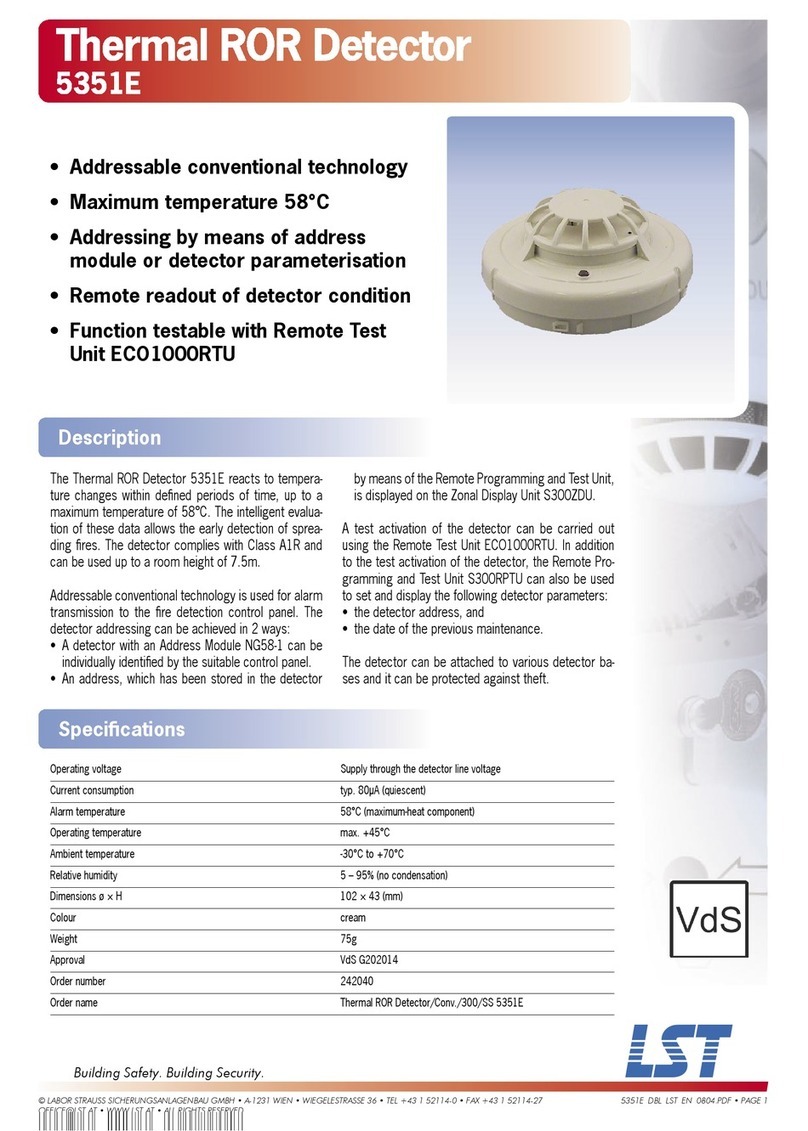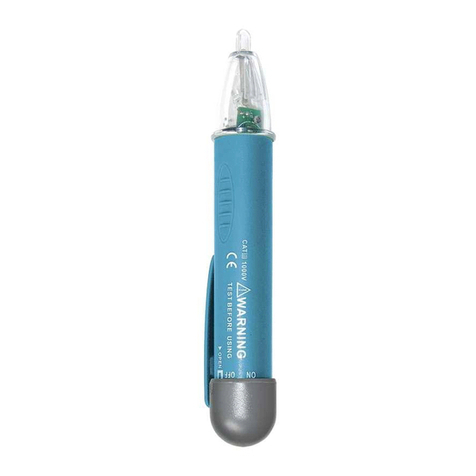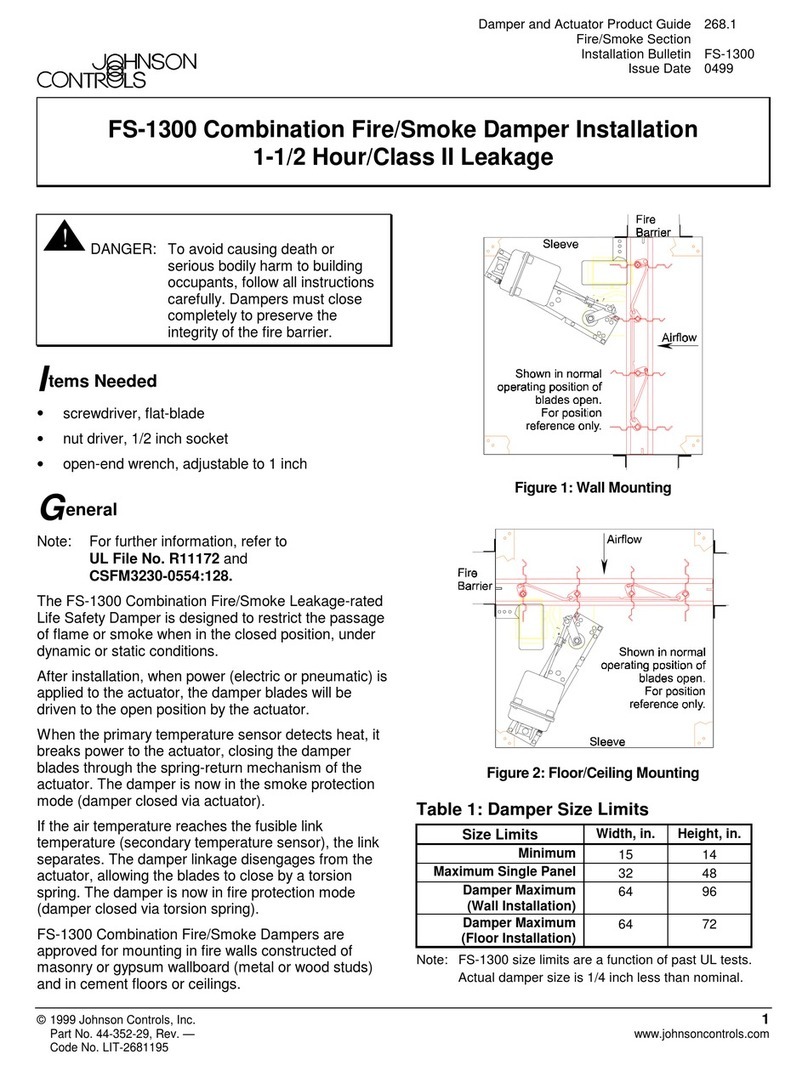Diablo Controls DSP-100 Series User manual

Diablo Controls, Inc.
Copyright © 2016
Document: DSP100_MAN_A
Released: December 20, 2016
Pros Who Know Trust Diablo
User Manual
DSP-100 Series
Vehicle Detector

DSP-100 User Manual Page 2 of 25 DSP100_MAN_A
1. Contents
Table of Figures ......................................................................................................................................................3
2. Introduction ...........................................................................................................................................4
3. Technical Data........................................................................................................................................5
Functional Data.......................................................................................................................................................5
Electrical Data.........................................................................................................................................................5
Environmental Data................................................................................................................................................6
Mechanical Data.....................................................................................................................................................6
4. Features and Functions...........................................................................................................................7
Detector Reset........................................................................................................................................................7
Presence Detection.................................................................................................................................................7
Pulse Detection.......................................................................................................................................................7
Fail-safe vs Fail-secure............................................................................................................................................7
Sensitivity................................................................................................................................................................8
Frequency ...............................................................................................................................................................8
Fail Memory Operation ..........................................................................................................................................9
Delay (Timing versions only)...................................................................................................................................9
Delay Inhibit (Timing versions only) .......................................................................................................................9
Extension (Timing versions only)............................................................................................................................9
Delay Inhibit/Extend on Green (Timing versions only).........................................................................................10
Indicators..............................................................................................................................................................11
5. Installation...........................................................................................................................................14
Detector Installation.............................................................................................................................................14
Loop Installation...................................................................................................................................................14
6. Configuration .......................................................................................................................................18
Basic DIP Switches ................................................................................................................................................18
Frequency (Switches 5 & 6)............................................................................................................................. 18
Presence / Pulse (Switch 4) ............................................................................................................................. 18
Sensitivity (Switches 1, 2, & 3) ........................................................................................................................ 18
Delay DIP Switches ...............................................................................................................................................19
Extension DIP Switches.........................................................................................................................................19
Internal Settings ...................................................................................................................................................20
Extend Only During Green (Jumper J1) ........................................................................................................... 20
Fail-Safe / Fail-Secure (Jumper J2)................................................................................................................... 20
Wiring ...................................................................................................................................................................21
7. Troubleshooting ...................................................................................................................................22
No Power LED .......................................................................................................................................................22
Power LED Flashes Slowly (1 Hz) ..........................................................................................................................22
Power LED Flashes Quickly (5 Hz).........................................................................................................................22
Power LED Shows Two Quick Flashes Once Every Two Seconds..........................................................................23
Detect LED Intermittently Comes On / Stays On Without a Vehicle Present.......................................................23
Detect LED Will Not Come On With a Vehicle Present.........................................................................................24

DSP-100 User Manual Page 3 of 25 DSP100_MAN_A
Table of Figures
Figure 1: DSP-100T and DSP-100 Detectors ...............................................................................................................4
Figure 2: Physical Dimensions ....................................................................................................................................6
Figure 3: Output with No Delay or Extension.............................................................................................................7
Figure 4: Output with Delay .......................................................................................................................................9
Figure 5: Output with Extension.............................................................................................................................. 10
Figure 6: Output with Delay and Extension............................................................................................................. 10
Figure 7: Extend Only During Green J1 Jumper Location ........................................................................................ 10
Figure 8: Power LED States...................................................................................................................................... 12
Figure 9: Detect LED States ..................................................................................................................................... 13
Figure 10: Loop Installation..................................................................................................................................... 16
Figure 11: Front Panel DIP Switches........................................................................................................................ 18
Figure 12: Internal Jumper Locations ...................................................................................................................... 20

DSP-100 User Manual Page 4 of 25 DSP100_MAN_A
2. Introduction
The DSP-100 vehicle detector has been specifically designed to handle most traffic applications and is very tolerant
of noise and cross-talk conditions. Working on virtually any size loop, the DSP-100 tunes itself automatically and
provides constant tracking to deal with environmental changes. The DSP-100’s inherent noise filtering algorithms
allow it to work reliably in almost any electrical situation.
The DSP-100 is available with a relay or solid-state output. The "RT" and "ST" models have front-panel switches
to select both extension and delay timing. The operation of the timing functions can be modified by using the
Delay Inhibit (also known as Phase Green) input.
The detector uses a 10-pin MS connector for connections.
Figure 1: DSP-100T and DSP-100 Detectors

DSP-100 User Manual Page 5 of 25 DSP100_MAN_A
3. Technical Data
Functional Data
Sensitivity: Eight sensitivities are user selectable.
Setting
S3
S2
S1
Sensitivity
0
OFF
OFF
OFF
1.28% -ΔL/L
1
OFF
OFF
ON
.64% -ΔL/L
2
OFF
ON
OFF
.32% - ΔL/L
3
OFF
ON
ON
.16% -ΔL/L
4
ON
OFF
OFF
.08% -ΔL/L
5
ON
OFF
ON
.04% -ΔL/L
6
ON
ON
OFF
.02% -ΔL/L
7
ON
ON
ON
.01% -ΔL/L
Frequency Settings: There are four frequency settings available. The actual loop frequency is
dependent on loop circuit inductance.
DIP Switch
Frequency
5
6
OFF
OFF
High
OFF
ON
Medium High
ON
OFF
Medium Low
ON
ON
Low
Response Time: Response time is dependent on the sensitivity selected.
Setting
Response Time
Setting
Response Time
0
88ms ±12ms
4
88ms ±12ms
1
88ms ±12ms
5
88ms ±12ms
2
88ms ±12ms
6
88ms ±12ms
3
88ms ±12ms
7
176ms ±24ms
Vehicle Hold Time: Approximately 1 hour for a detection of 1% -ΔL/L.
Electrical Data
Loop Inductance: 20 microhenries to 1500 microhenries (including lead-in inductance). Not all
frequency settings are available at inductances below 30 microhenries.
Operating Voltages: 90 volts to 140 volts AC
Output Rating: Solid-State Open Collector, 30 mA max, 30 VDC max.
Relay 3A, 150 VDC or 300 VAC
Operating Voltage: 90 to 140 volts AC

DSP-100 User Manual Page 6 of 25 DSP100_MAN_A
Environmental Data
Operating Temperature: -35°F to 165°F (-37°C to 74°C)
Storage Temperature: -40°F to 176°F (-40°C to 80°C)
Humidity: Up to 95% relative humidity non-condensing
Mechanical Data
Mounting Orientation: Any orientation is acceptable
Housing Material: Extruded aluminum housing. Sheet aluminum front and rear plates.
Housing Size: 3.500 inches (High) x 2.130 inches (Wide) x 4.231 inches (Deep)
88.90 mm (High) x 54.10 mm (Wide) x 107.47 mm (Deep)
Figure 2: Physical Dimensions

DSP-100 User Manual Page 7 of 25 DSP100_MAN_A
4. Features and Functions
Detector Reset
When any of the 6-position DIP switches (and the 12 DIP switches on the timing version) are changed, the detector
will perform a detector wide reset. Depending how the internal jumper (J2) is set, the LEDs will blink differently.
If the jumper is installed indicating fail-safe operation, both LEDs will blink 500 milliseconds on and off for two
seconds. If the jumper (J2) is not installed indicating fail-secure operation, the LEDs will flash at 50 milliseconds
on and 50 milliseconds off rate for two seconds before returning to their normal states. The detector will not
output any detections during this two second reset period. If a prior loop fault is being displayed it will be cleared.
If a vehicle is over the loop during the reset period it will not be detected.
Presence Detection
If DIP switch 4 (labeled PULSE) is off, the detector will operate in the presence detection mode. The Delay and
Extend features may modify the output behavior. Once activated, the output will remain activated as long as a
vehicle is detected over the loop. After four minutes of continuous detection, the detector will begin to slowly
retune the detector with the goal of tuning out the vehicle that is stalled or parked on the loop over a relatively
long time. The retuning process takes about an hour to complete when tuning out a vehicle detection of 1% ΔL/L.
When the retuning process is complete, any loop area that vehicles can still travel over will still detect a vehicle
as expected. Once the vehicle leaves, the detector will recover from the retuning process within 1 second.
Pulse Detection
If DIP switch 4 (labeled PULSE) is on, the detector will operate in the pulse mode (Pulse on Entry). The pulse
generated by the output will be 125 milliseconds long. The output will follow any programmed Delay time, but
any Extend time will be ignored. If the vehicle remains on the loop detection area for two seconds, the detector
will automatically retune. Thus, any increase in signal strength (decrease in inductance) that exceeds the selected
sensitivity will generate an additional output pulse.
Figure 3: Output with No Delay or Extension
Fail-safe vs Fail-secure
Vehicle detectors can be operated in one of two modes: fail-safe or fail-secure. In general, a fail-safe detector will
activate the output when the loop circuit is failed. This is useful on most calling detectors, stop bar detectors, and
safety loops. Fail-safe is used in applications where it is important to not have an output active if the loop circuit

DSP-100 User Manual Page 8 of 25 DSP100_MAN_A
has failed. The fail-secure mode is useful in counting detectors, speed detectors, and high-security areas or
installations where containment is needed.
A jumper (J2) on the PC board inside the unit determines whether the detector operates in fail-safe or fail-secure.
All DSP-100 detectors come with the jumper installed giving fail-safe operation. If fail-secure operation is desired,
simply remove the jumper (J2).
Sensitivity
The detector has eight user selectable sensitivity levels. In most situations the medium sensitivity 4 setting will
work effectively. For those situations where setting 4 is not sensitive enough, raise the sensitivity one level at a
time until the desired performance is obtained. For those situations where the detector is oversensitive, lower
the sensitivity one level at a time until the desired performance is obtained. The sensitivity is factory set to 0.
Like most inductive loop vehicle detectors, the DSP-100 directly measures the change in frequency of the loop
and from there, calculates the change in inductance when a vehicle interacts with it. The change in inductance is
measured as -ΔL/L (reads as “minus delta L over L”) and is usually expressed as a percentage.
For the eight sensitivities, the thresholds, switch settings, and response times are:
Level
-∆L/L
S1
S2
S3
Response Time
Lowest
0
1.28%
Off
Off
Off
88ms ±12ms
1
.64%
On
Off
Off
88ms ±12ms
2
.32%
Off
On
Off
88ms ±12ms
3
.16%
On
On
Off
88ms ±12ms
Normal
4
.08%
Off
Off
On
88ms ±12ms
5
.04%
On
Off
On
88ms ±12ms
6
.02%
Off
On
On
88ms ±12ms
Highest
7
.01%
On
On
On
176ms ±24ms
Frequency
When loops are installed sufficiently far apart from each other, any two loops will not interfere with each other.
However, if two loops are fairly close together (this distance depends on the size of the loops) the inductive fields
may couple together and may interact causing intermittent false detections. The two main variables for inductive
coupling are distance and frequency separation. To aid in avoiding inductive coupling of loops, each DSP-100 unit
comes with two frequency switches. They are binary coded allowing up to four different frequencies to operate
at. If there are suspicions that loops are interacting, change one of the detector’s frequency settings.
DIP Switch
Frequency
5
6
OFF
OFF
High
OFF
ON
Medium High
ON
OFF
Medium Low
ON
ON
Low

DSP-100 User Manual Page 9 of 25 DSP100_MAN_A
Fail Memory Operation
Normal operation during a loop failure is the green Power LED indicating what type of loop failure (open, short,
or large ΔL/L). During the loop failure, the red Detect LED and the output will be active for fail-safe operation or
inactive for fail-secure operation. If the loop recovers from its failure, the red LED along with the output will
operate normally again. However, the green LED will display Fail Memory by blinking 1850 milliseconds on, 50
milliseconds off, 50 milliseconds on again, and then 50 milliseconds off. This blinking sequence will repeat until a
reset or power cycle occurs. This blinking sequence will inform the user that sometime in the past this particular
detector detected a loop failure.
Delay (Timing versions only)
Delay is the time added after a vehicle arrives in the detection area but before the output is activated. During the
delay interval the output relay will remain de-activated, requiring that the vehicle stay in the detection area for
the full delay time before activating the output. This is useful at sites where right turns on red are allowed. This
allows a vehicle to arrive at a red signal, come to a full stop, and proceed to make a right turn without the detector
ever activating and placing a call into a phase. This interval is indicated by the red Detect LED blinking slowly at
200 milliseconds on followed by 200 milliseconds off repeatedly until the interval is complete. Delay time can be
set from 1 second to 63 seconds in 1 second increments.
Figure 4: Output with Delay
Delay Inhibit (Timing versions only)
Normal operation always honors any programmed delay time. However, by connecting the AC green input for
that phase to connector pin J (Delay Inhibit), the DSP-100 will delay only when the green is not active. During the
green interval, any programmed delay time will be ignored.
Extension (Timing versions only)
Extension is the time added after a vehicle leaves the detection area. During this interval, the output will remain
activated. If another vehicle arrives during this extension interval, the remainder of the extension time is canceled
and the detector returns to the normal presence state. This interval is indicated by the red Detect LED blinking
fast at 50 milliseconds on followed by 50 milliseconds off repeatedly until the interval is complete. Extension time
can be set from 0.25 seconds to 15.75 seconds in 0.25 second increments.

DSP-100 User Manual Page 10 of 25 DSP100_MAN_A
Figure 5: Output with Extension
Figure 6: Output with Delay and Extension
Delay Inhibit/Extend on Green (Timing versions only)
Normal operation always honors any programmed extension time. By removing jumper J1 inside the detector,
and connecting the AC green input for that phase to connector pin J (Delay Inhibit), the DSP-100 can be set to
extend only during the green interval. Any vehicle exiting the detection area during the non-green intervals of
the associated phase will not activate the extension interval on the detector.
Figure 7: Extend Only During Green J1 Jumper Location

DSP-100 User Manual Page 11 of 25 DSP100_MAN_A
Indicators
The DSP-100 is equipped with two LED indicators: Power (Green) and Detect (Red).
Power LED –The green power LED indicates these possible states:
Off The voltage applied to the detector is insufficient. The LED will be off.
Reset in Fail-safe At the start of a reset event (a DIP switch change, sensitivity change, or
power cycle) the LED will turn off for 500 milliseconds, on for 500
milliseconds, off for 500 milliseconds, off for 500 milliseconds, and then
display its normal state.
Reset in Fail-secure At the start of a reset event (a DIP switch change, sensitivity change, or
power cycle) the LED will blink repeatedly with 50 milliseconds on
followed by 50 milliseconds off for two seconds, and then display its
normal state.
Open Loop When the detector senses that the loop is open or the inductance is too
high, the LED will turn on for 500 milliseconds then off for 500
milliseconds repeatedly, for the duration of the fault.
If the fault is corrected, the Fail Memory feature will display the Prior
Fault indication.
Shorted Loop When the detector senses that a loop is shorted or the inductance is too
low, the LED will turn on for 100 milliseconds then off for 100 milliseconds
repeatedly, for the duration of the fault.
If the fault is corrected, the Fail Memory feature will display the Prior
Fault indication.
Large Change Fault When the detector senses that a loop is experiencing a large inductance
change (greater than 30%), the LED will turn off for 100 milliseconds then
on for 100 milliseconds for 500 milliseconds then stay on for 500
milliseconds and repeat the sequence for the duration of the fault.
If the fault is corrected, the Fail Memory feature will display the Prior
Fault indication.
Prior Fault The detector is equipped with the ability to remember prior faults that
have occurred since the last power interruption or reset (changing a DIP
switch or the sensitivity). The LED will turn on for 1850 milliseconds, off
for 50 milliseconds, on for 50 milliseconds, off for 50 milliseconds and
then repeat the sequence until power is cycled or the detector reset.
Normal The LED is always on when the detector is in its normal state of operation.

DSP-100 User Manual Page 12 of 25 DSP100_MAN_A
Figure 8: Power LED States
Detect LED –The red detect LED is used to display the status of the A output. There are several different
statuses that can be displayed on this LED:
Off No vehicle present in the detection area.
Reset in Fail-safe At the start of a reset event (a DIP switch change, sensitivity change, or
power cycle) the LED will turn off for 500 milliseconds, on for 500
milliseconds, off for 500 milliseconds, on for 500 milliseconds, and then
finally display its normal state.
Reset in Fail-secure At the start of a reset event (a DIP switch change, sensitivity change, or
power cycle) the LED will turn off for 500 milliseconds, on for 500
milliseconds, blink repeatedly with 50 milliseconds on followed by 50
milliseconds off for one second, and then display its normal state.
Delay Interval A vehicle has been detected but the output is not activated due to the
programmed delay feature being active. The LED will turn on for 200
milliseconds and then off for two hundred milliseconds. If the vehicle
leaves the detection area before the programmed delay interval expires,
the LED will return to the off state. If the vehicle is still present after the
programmed delay time has expired, the LED will become solid and the
output will be activated.

DSP-100 User Manual Page 13 of 25 DSP100_MAN_A
Extension Interval A vehicle was detected but the detection zone is now empty. When the
detection area becomes vacant, the extension timer will start and the
output will continue to be activated. During this interval, the LED will
blink quickly at 50 milliseconds on and 50 milliseconds off. If another
vehicle enters the detection area during this interval, the extension time
is cancelled and the LED will return to the solid state. Note: There is no
delay interval for any newly arriving vehicle if a vehicle is already in the
detection area or the detector is in the extension interval.
Figure 9: Detect LED States

DSP-100 User Manual Page 14 of 25 DSP100_MAN_A
5. Installation
Detector Installation
Location: The detector should be installed in a weatherproof location that is near the loop. Ideally, a technician
should be able to see the loop and the detector at the same time.
Mounting: The detector will function when mounted in any orientation. The unit is designed to simply sit on a
shelf. It is best to mount the detector such that the front panel will be easily accessible for configuration and
troubleshooting. When using a detector harness, be sure to leave enough of the wiring harness to allow the
technician to easily work with the detector.
Wiring: The detector will come with a side label identifying how the detector is pinned out. Wire nuts can be
used for most connections to the wires in a detector wiring harness. However, wire nuts should never be used at
any point in the loop circuit itself. All loop connections should be crimped or screw terminals at a minimum and
soldered for best long term reliability.
Special attention should be paid to ensure that the loop wires remain tightly twisted together. An air gap between
the two wires for a loop may cause the detector to lock up if the wires are disturbed.
Loop Installation
The reliability and overall performance of the detector are greatly dependent on the loop itself. Several factors
go into a good loop installation: type of wire used, loop configuration, and installation practices.
Type of Wire Used: The wire used for wiring the loop should have a jacket of cross-linked polyethylene. This
would be a wire with an XLP jacket such as XHHW. THHN or similar wire types should never be used for loop wire.
The gauge of the wire to use depends on two factors: Distance in cable feet from the loop to the detector and
stresses the wire may see. The gauge of the wire can be 20 AWG as long as the detector is within 50 feet of the
loop in cable distance. For 50 to 100 feet, use at least 18 AWG wire. At greater than 100 feet, use a 16 AWG wire
at a minimum. If the loop is installed in asphalt and there will be heavy vehicles or stopping and starting vehicles
in the loop area, a 14 AWG or 12 AWG should be used to provide additional strength to the loop. This helps
increase the life of the loop in areas where the asphalt may slowly move and/or deform due to wear.
Loop Configuration: The size and shape of the loop will determine what type of vehicles it can reliably detect.
There are many variables that come into play including loop dimensions, percent of coverage, length of lead-in
wire, number of turns in the loop area, and detection height to name just a few of them. One common rule is
that the useable field height of a loop is 2
3of the shortest leg of the loop. So, if you plan on using a 6’ x 6’ loop, the
expected useable detection height would be 48” (The shortest leg is 6’ or 72”, 72” x 2 = 144”, 144” / 3 = 48”).
Loop size and the number of turns are very important. If these values are inadequate, detection and reliability
will be compromised. The first consideration is the inductance in the lead-in length. The standard rule of thumb
for calculating the inductance of the lead-in is .22 microhenries per foot. So, for example, a 250’ lead-in would
have 55 µH of inductance. The second consideration is the inductance of the loop. As a minimum, the loop

DSP-100 User Manual Page 15 of 25 DSP100_MAN_A
inductance should be twice the lead-in inductance. To approximate the loop inductance, use the following
formula:
L = (P / 4) x (N + N2)
Where:
L = Loop Inductance in microhenries (µH)
P = Perimeter of loop in feet
N = Number of turns in the loop
For example, a typical 6’x6’ loop with 3 turns would have an inductance of
L = ( (6 + 6 + 6 + 6) / 4) x (3 + 32)
L = (24 / 4) x (3 + 9)
L = 6 x 12
L = 72 µH
Loop Inductance is approximately 72 µH. The approximate inductance of a 250’ lead-in cable was calculated using
a value of .22 µH per foot. That should equal about 55 µH for the lead-in. A good installation should have a loop
inductance to lead-in inductance ratio of at least 2 to 1. So, with a 250’ lead-in and inductance of 55 µH, the loop
inductance should be at least 110 µH. So, in our example of a 6’ x 6’ loop with three turns yielding an inductance
of 72 µH is not a good installation. A four turn 6’ x 6’ loop would have an inductance of approximately 120 µH and
would there meet the ratio guideline. If you are unsure about your particular installation, call tech support for
guidance.
Installation Practices: Permanent loops should be installed into the road surface by cutting slots into the road
surface using a saw with an appropriate cutting disk for the road surface.
The slot cut should be wide enough that the wire being used will easily fit into the slot. This is needed so that the
loop sealant used can fully encapsulate the wire. When the wire fits tightly in the slot, the sealant may not be
able to get below the wire, leaving air pockets in the saw slot. If water finds its way into these air pockets, over
time, freeze/thaw cycles can slowly jack the loop out of the saw slot causing loop failure.
The saw slot should be deep enough that the loop wire will have a minimum of ½” of sealant over the top wire in
the slot. More is better. Going too deep with the saw cut is also a concern. Deep cuts in a road surface may
impact the structural strength of the roadway, especially if any reinforcement material is cut. Using a smaller
gauge of wire will allow for shallower saw cuts.

DSP-100 User Manual Page 16 of 25 DSP100_MAN_A
Figure 10: Loop Installation
The corners of the loop should be crosscut at a 45°to help prevent damage to the wire insulation during
installation and temperature cycling. The angled cuts should be at least 9” back from where the corner would be.
The saw cuts should not go any further than necessary to ensure that the saw slots are at full depth where they
meet.
Once the saw slot has been cut, the slot should be cleaned of all loose material. High pressure air should be
directed in to the saw slot to remove all debris. This will also help remove dust from the saw cutting operation
from the sides of the saw slot. This will allow better adhesion of the loop sealant to the saw slot.
The loop wire should be installed as a continuous piece of wire from the detector to the loop, all of the turns in
the loop, and back to the detector. Remember to make allowance for shrinkage in the wire length when the
portion of the wire not in the roadway surface is twisted. The twisting is important for dealing with electrical
noise. A splice of the loop wire should never be made in the roadway. If the loop wire needs to be spliced to
another cable to get to the detector, the splice should be done in a junction box and the connections should be
soldered and weatherproofed. Wire nuts should never be used at any point in the loop circuit.
In order to keep the loop wire at the bottom of the saw slot, 1” to 2” pieces of backer rod should be placed in the
saw slot every 1 to 2 feet. The backer rod should be sized such that it fits snugly in the saw slot. Use a blunt object
(not a screwdriver) to press the backer rod pieces down into the saw slot as far as they will go. Keeping the loop
Backer Rod Piece
Saw Cut
Loop Wires

DSP-100 User Manual Page 17 of 25 DSP100_MAN_A
wire at the bottom of the saw slot allows the loop sealant to provide the maximum amount of protection possible
from foreign object penetration. Never use a continuous piece of backer rod over the loop, as this would prevent
the loop sealant from encapsulating the loop wire.
The loop sealant used should be appropriate for the roadway surface that was cut. Generally, epoxy or polyester
based sealants are used for concrete surfaces and polyester or urethane based sealants are used for asphalt
surfaces. However, these are not hard guidelines and specific circumstances will determine which type of sealant
should be used.
Once the loop wire leaves the saw slot it should be twisted at least three times per foot. More is better. The
twists should be kept tight to be most effective in reducing the effects of electrical interference.

DSP-100 User Manual Page 18 of 25 DSP100_MAN_A
6. Configuration
Basic DIP Switches
The front panel DIP switches facilitate easily
changing most of the operating parameters of the
DSP-100 detector.
When a DIP switch is moved toward the numbers
printed on the DIP switch, the switch is in the OFF
position. When moved toward the “ON” printed on
the DIP switch, the switch is in the ON position.
The basic detector has the DIP switch on the right
and does not have the Delay and Extension DIP
switches on the left side. The detector front panel
pictured to the left is a DSP-100T detector with
timing features.
Frequency (Switches 5 & 6) –These two switches select the amount of capacitance added to the loop circuit.
The more capacitance the lower the operating frequency. To aid in avoiding inductive coupling (cross-talk) of
loops, each DSP-100 unit comes with two frequency switches. They are binary coded allowing up to four different
frequencies to operate at. If there are suspicions that loops are interacting, change one of the detector’s
frequency settings.
DIP Switch
Frequency
5
6
OFF
OFF
High
OFF
ON
Medium High
ON
OFF
Medium Low
ON
ON
Low
Presence / Pulse (Switch 4) –This switch selects what output mode the detector operates in. When the switch
is off, the detector will operate in the presence mode. The output will be activated while a vehicle is detected
over the loop. When the switch is on, the detector will operate in the pulse mode. The output will activate for
125 milliseconds when a vehicle is detected. Delay and Extension features will modify how the output responds
in either mode.
Sensitivity (Switches 1, 2, & 3) –These switches select one of eight possible sensitivities of the detector. Like
most inductive loop vehicle detectors, the DSP-100 directly measures the change in frequency of the loop and
from there, calculates the change in inductance when a vehicle interacts with it. The change in inductance is
measured as -ΔL/L (reads as “minus delta L over L”) and is usually expressed as a percentage.
Figure 11: Front Panel DIP Switches

DSP-100 User Manual Page 19 of 25 DSP100_MAN_A
For the eight sensitivities, the thresholds, switch settings, and response times are:
Level
-∆L/L
S1
S2
S3
Response Time
Lowest
0
1.28%
Off
Off
Off
88ms ±12ms
1
.64%
On
Off
Off
88ms ±12ms
2
.32%
Off
On
Off
88ms ±12ms
3
.16%
On
On
Off
88ms ±12ms
Normal
4
.08%
Off
Off
On
88ms ±12ms
5
.04%
On
Off
On
88ms ±12ms
6
.02%
Off
On
On
88ms ±12ms
Highest
7
.01%
On
On
On
176ms ±24ms
Delay DIP Switches
Delay is the time added after a vehicle arrives in the detection area but before the output is activated. During the
delay interval the output relay will remain de-activated, requiring that the vehicle stay in the detection area for
the full delay time before activating the output. This is useful at sites where right turns on red are allowed. This
allows a vehicle to arrive at a red signal, come to a full stop, and proceed to make a right turn without the detector
ever activating and placing a call into a phase. This interval is indicated by the red Detect LED blinking slowly at
200 milliseconds on followed by 200 milliseconds off repeatedly until the interval is complete. Delay time can be
set from 1 second to 63 seconds in 1 second increments. The following table shows the switch settings for the
various possible time values.
1
2
4
8
16
32
1
2
4
8
16
32
1
2
4
8
16
32
1
2
4
8
16
32
0
Off
Off
Off
Off
Off
Off
16
Off
Off
Off
Off
On
Off
32
Off
Off
Off
Off
Off
On
48
Off
Off
Off
Off
On
On
1
On
Off
Off
Off
Off
Off
17
On
Off
Off
Off
On
Off
33
On
Off
Off
Off
Off
On
49
On
Off
Off
Off
On
On
2
Off
On
Off
Off
Off
Off
18
Off
On
Off
Off
On
Off
34
Off
On
Off
Off
Off
On
50
Off
On
Off
Off
On
On
3
On
On
Off
Off
Off
Off
19
On
On
Off
Off
On
Off
35
On
On
Off
Off
Off
On
51
On
On
Off
Off
On
On
4
Off
Off
On
Off
Off
Off
20
Off
Off
On
Off
On
Off
36
Off
Off
On
Off
Off
On
52
Off
Off
On
Off
On
On
5
On
Off
On
Off
Off
Off
21
On
Off
On
Off
On
Off
37
On
Off
On
Off
Off
On
53
On
Off
On
Off
On
On
6
Off
On
On
Off
Off
Off
22
Off
On
On
Off
On
Off
38
Off
On
On
Off
Off
On
54
Off
On
On
Off
On
On
7
On
On
On
Off
Off
Off
23
On
On
On
Off
On
Off
39
On
On
On
Off
Off
On
55
On
On
On
Off
On
On
8
Off
Off
Off
On
Off
Off
24
Off
Off
Off
On
On
Off
40
Off
Off
Off
On
Off
On
56
Off
Off
Off
On
On
On
9
On
Off
Off
On
Off
Off
25
On
Off
Off
On
On
Off
41
On
Off
Off
On
Off
On
57
On
Off
Off
On
On
On
10
Off
On
Off
On
Off
Off
26
Off
On
Off
On
On
Off
42
Off
On
Off
On
Off
On
58
Off
On
Off
On
On
On
11
On
On
Off
On
Off
Off
27
On
On
Off
On
On
Off
43
On
On
Off
On
Off
On
59
On
On
Off
On
On
On
12
Off
Off
On
On
Off
Off
28
Off
Off
On
On
On
Off
44
Off
Off
On
On
Off
On
60
Off
Off
On
On
On
On
13
On
Off
On
On
Off
Off
29
On
Off
On
On
On
Off
45
On
Off
On
On
Off
On
61
On
Off
On
On
On
On
14
Off
On
On
On
Off
Off
30
Off
On
On
On
On
Off
46
Off
On
On
On
Off
On
62
Off
On
On
On
On
On
15
On
On
On
On
Off
Off
31
On
On
On
On
On
Off
47
On
On
On
On
Off
On
63
On
On
On
On
On
On
Extension DIP Switches
Extension is the time added after a vehicle leaves the detection area. During this interval, the output will remain
activated. If another vehicle arrives during this extension interval, the remainder of the extension time is canceled
and the detector returns to the normal presence state. This interval is indicated by the red Detect LED blinking
fast at 50 milliseconds on followed by 50 milliseconds off repeatedly until the interval is complete. Extension time
can be set from 0.25 seconds to 15.75 seconds in 0.25 second increments. The following table shows the switch
settings for the various possible time values.

DSP-100 User Manual Page 20 of 25 DSP100_MAN_A
.25
.5
1
2
4
8
.25
.5
1
2
4
8
.25
.5
1
2
4
8
.25
.5
1
2
4
8
0.00
Off
Off
Off
Off
Off
Off
4.00
Off
Off
Off
Off
On
Off
8.00
Off
Off
Off
Off
Off
On
12.00
Off
Off
Off
Off
On
On
0.25
On
Off
Off
Off
Off
Off
4.25
On
Off
Off
Off
On
Off
8.25
On
Off
Off
Off
Off
On
12.25
On
Off
Off
Off
On
On
0.50
Off
On
Off
Off
Off
Off
4.50
Off
On
Off
Off
On
Off
8.50
Off
On
Off
Off
Off
On
12.50
Off
On
Off
Off
On
On
0.75
On
On
Off
Off
Off
Off
4.75
On
On
Off
Off
On
Off
8.75
On
On
Off
Off
Off
On
12.75
On
On
Off
Off
On
On
1.00
Off
Off
On
Off
Off
Off
5.00
Off
Off
On
Off
On
Off
9.00
Off
Off
On
Off
Off
On
13.00
Off
Off
On
Off
On
On
1.25
On
Off
On
Off
Off
Off
5.25
On
Off
On
Off
On
Off
9.25
On
Off
On
Off
Off
On
13.25
On
Off
On
Off
On
On
1.50
Off
On
On
Off
Off
Off
5.50
Off
On
On
Off
On
Off
9.50
Off
On
On
Off
Off
On
13.50
Off
On
On
Off
On
On
1.75
On
On
On
Off
Off
Off
5.75
On
On
On
Off
On
Off
9.75
On
On
On
Off
Off
On
13.75
On
On
On
Off
On
On
2.00
Off
Off
Off
On
Off
Off
6.00
Off
Off
Off
On
On
Off
10.00
Off
Off
Off
On
Off
On
14.00
Off
Off
Off
On
On
On
2.25
On
Off
Off
On
Off
Off
6.25
On
Off
Off
On
On
Off
10.25
On
Off
Off
On
Off
On
14.25
On
Off
Off
On
On
On
2.50
Off
On
Off
On
Off
Off
6.50
Off
On
Off
On
On
Off
10.50
Off
On
Off
On
Off
On
14.50
Off
On
Off
On
On
On
2.75
On
On
Off
On
Off
Off
6.75
On
On
Off
On
On
Off
10.75
On
On
Off
On
Off
On
14.75
On
On
Off
On
On
On
3.00
Off
Off
On
On
Off
Off
7.00
Off
Off
On
On
On
Off
11.00
Off
Off
On
On
Off
On
15.00
Off
Off
On
On
On
On
3.25
On
Off
On
On
Off
Off
7.25
On
Off
On
On
On
Off
11.25
On
Off
On
On
Off
On
15.25
On
Off
On
On
On
On
3.50
Off
On
On
On
Off
Off
7.50
Off
On
On
On
On
Off
11.50
Off
On
On
On
Off
On
15.50
Off
On
On
On
On
On
3.75
On
On
On
On
Off
Off
7.75
On
On
On
On
On
Off
11.75
On
On
On
On
Off
On
15.75
On
On
On
On
On
On
Internal Settings
There are two jumpers on the inside of the detector case labelled J1 and J2. See figure below for location of these
jumpers.
Extend Only During Green (Jumper J1) –This jumper
modifies the extension feature. Normal operation always
honors any programmed extension time. By removing jumper
J1 inside the detector, and connecting the AC green input for
that phase to connector pin J (Delay Inhibit), the DSP-100 can
be set to extend only during the green interval. Any vehicle
exiting the detection area during the non-green intervals of the
associated phase will not activate the extension interval on the
detector. The detector is shipped from the factory with this
jumper installed.
Fail-Safe / Fail-Secure (Jumper J2) –This jumper selects
fail-safe or fail-secure operation. If the jumper is installed, as
in the figure below, the detector will behave in the fail-safe
mode. To have the detector behave in the fail-secure mode,
simply remove the J2 jumper. The detector is shipped from the
factory with this jumper installed (the fail-safe condition).
In general, a fail-safe detector will activate the output when the loop circuit is failed. This is useful on most calling
detectors, stop bar detectors, and safety loops. Fail-safe is used in applications where it is important to not have
an output active if the loop circuit has failed. The fail-secure mode is useful in counting detectors, speed detectors,
and high-security areas or installations where containment is needed.
Figure 12: Internal Jumper Locations
Table of contents
Other Diablo Controls Security Sensor manuals
Popular Security Sensor manuals by other brands
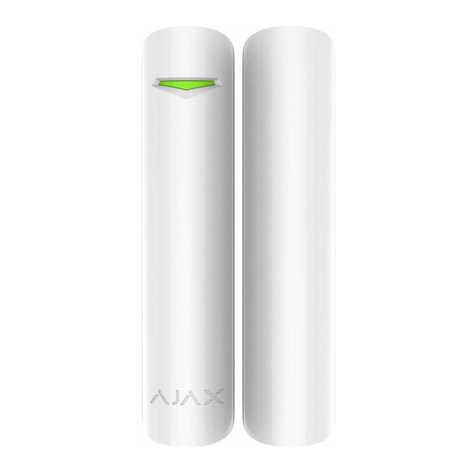
AJAX
AJAX DoorProtect Plus quick start guide
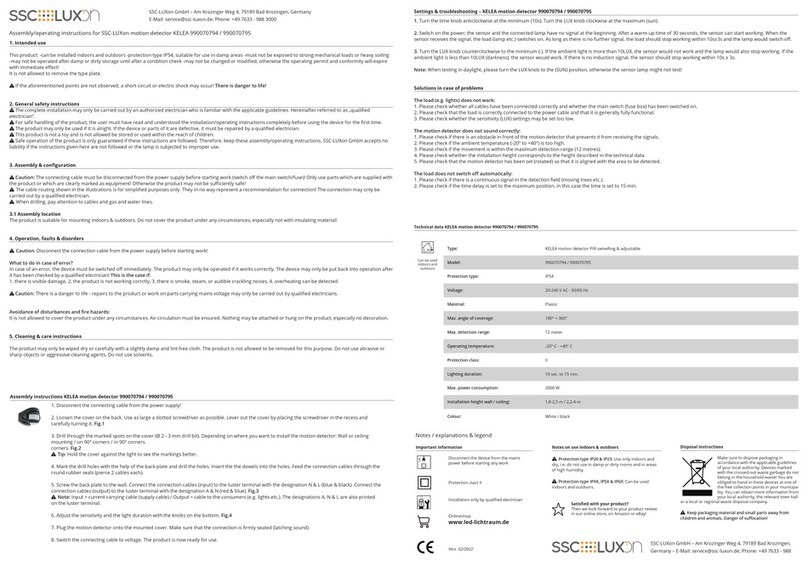
SSC
SSC KELEA 990070794 Assembly & operating instructions
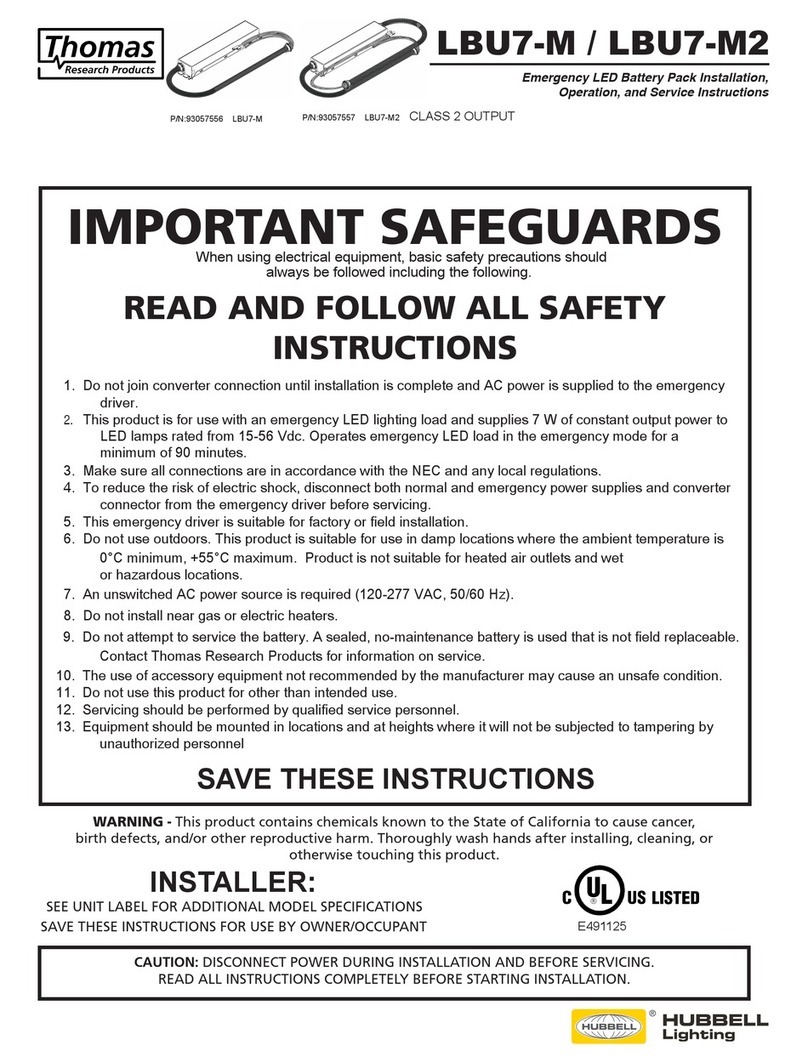
Thomas Research Products
Thomas Research Products LBU7-M Installation, operation and service instructions
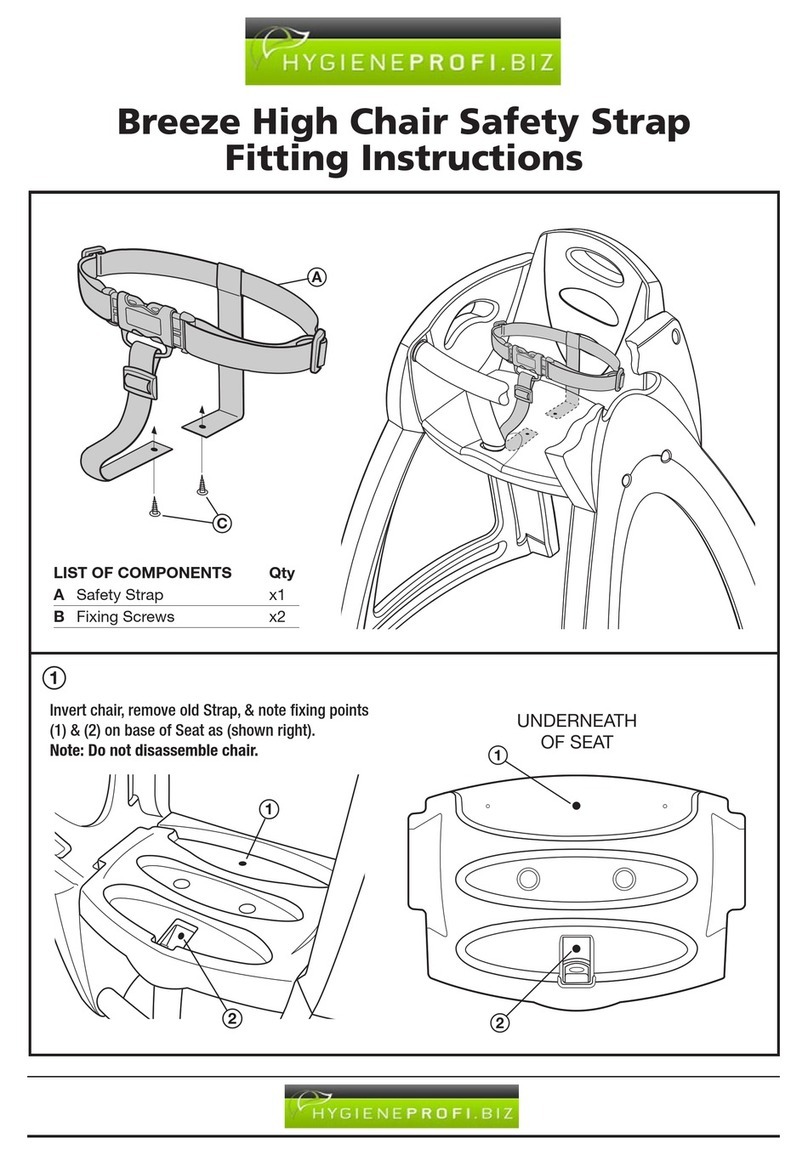
Hygieneprofi
Hygieneprofi Breeze Fitting instructions

Textron
Textron HDE TAG-200 Operating instructions manual
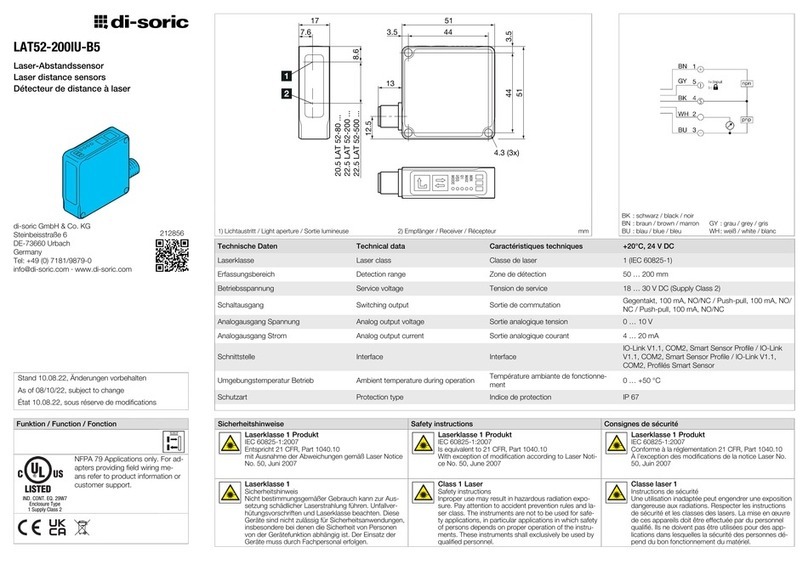
Di-soric
Di-soric LAT52-200IU-B5 manual
